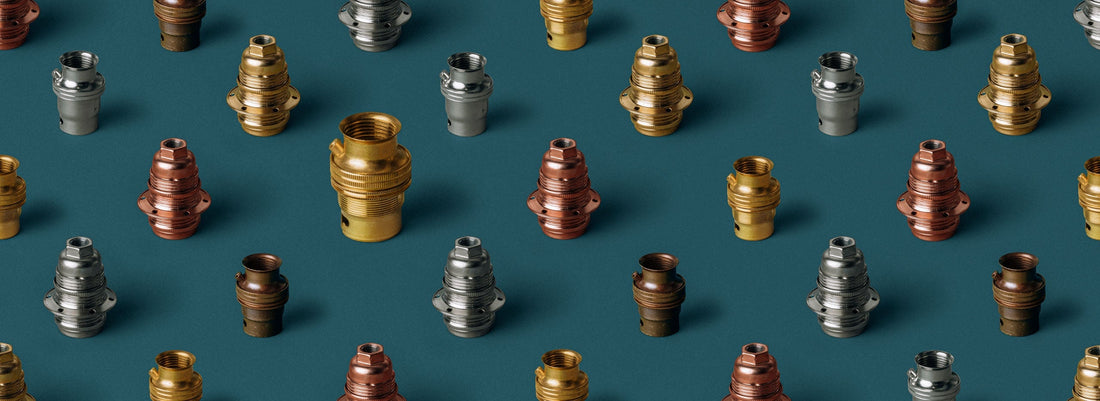
Confused about Lampholder Types? Read our Guide!
Share
A Comprehensive Guide to Lampholders in the UK: Types, Features, and Applications
When it comes to lighting fixtures, lampholders are often the unsung heroes. These essential components hold light bulbs securely in place and are designed to provide an electrical connection to power the bulb. Whether you're upgrading your light fittings or replacing a broken lampholder, it’s important to know the different types available on the UK market to ensure compatibility, safety, and the desired lighting effect. This article will explore the various types of lampholders commonly available in the UK, their features, and their applications.
1. B22 (Bayonet Cap) Lampholder
Overview:
The B22, or Bayonet Cap, is the traditional and one of the most widely used lampholders in the UK, particularly in domestic settings. It features a two-pronged bayonet fitting that secures the light bulb by pushing and twisting it into place. The B22 base is common for many types of light bulbs, including incandescent, halogen, and LED bulbs.
Applications:
- Common in ceiling lights, table lamps, and floor lamps
- Ideal for standard domestic lighting needs
Features:
- Quick and easy installation and removal of bulbs
- Provides a secure connection and prevents accidental bulb detachment
2. E27 (Edison Screw) Lampholder
Overview:
Taking over the market, the E27 (Edison Screw) lampholder uses a threaded fitting to secure the light bulb, making it a more universal option compared to the B22 bayonet. The E27 is widely used around the world, and in the UK, it is often found in light fittings that require larger, high-wattage bulbs.
Applications:
- Suitable for larger pendant lights, lamps, and some commercial lighting setups
- Compatible with a range of bulbs, including energy-saving and LED varieties
Features:
- More common in decorative and industrial-style lighting
- Easy to screw in and replace bulbs
- Versatile and available for both smaller (E14) and larger (E27) screw fittings
3. E14 (Small Edison Screw) Lampholder
Overview:
The E14 is a smaller version of the E27 screw fitting, often referred to as the "small Edison screw" (SES). It’s typically used for smaller bulbs such as those found in chandeliers, wall sconces, and table lamps.
Applications:
- Perfect for smaller light fittings like chandeliers, bedside lamps, and some decorative lighting
- Common in vintage or decorative lamp designs
Features:
- Compatible with smaller wattage bulbs
- Popular in traditional and vintage-style lighting designs
4. B15 (Mini Bayonet) Lampholder
Overview:
The B15 is a smaller version of the standard B22 bayonet fitting. It is often used in applications requiring smaller bulbs, such as for night lights, decorative lamps, and some ceiling fixtures.
Applications:
- Ideal for small light fittings, such as nightlights and decorative pendant lamps
- Common in domestic settings where smaller, lower-wattage bulbs are preferred
Features:
- Offers secure bayonet fitting in smaller, more compact designs
- Compatible with a variety of low-wattage bulbs, including LED and incandescent options
5. G9 Lampholder
Overview:
The G9 lampholder is another compact option that holds a bi-pin halogen or LED bulb. It is often used for decorative lighting, chandeliers, or smaller fixtures where space is limited.
Applications:
- Frequently used in chandeliers, pendant lights, and small table lamps
- Ideal for installations where a compact light source is required
Features:
- Easy to install with a push-and-lock mechanism
- Common in decorative and accent lighting setups
Key Considerations When Choosing a Lampholder:
- Voltage Compatibility: Ensure the lampholder matches the voltage of the bulb. For example, MR16 and G4 lamps may require a low-voltage power source.
- Wattage Limits: Check the wattage ratings on the lampholder to avoid overheating or damage to the fitting.
- Bulb Type: Match the lampholder with the type of bulb you're using. Some lampholders are only compatible with specific bulb types, such as LED, halogen, or incandescent.
- Fixture Compatibility: Consider the type of light fixture and the space available for installation, especially in compact or decorative lighting setups.
Conclusion
Choosing the right lampholder is essential for ensuring both functionality and safety in lighting installations. By understanding the different types of lampholders available on the UK market, you can select the most suitable option for your lighting needs. Whether you’re updating your home lighting, installing spotlights, or fitting a new chandelier, there’s a lampholder for every application. Always consider the compatibility with the light bulb type, voltage, and wattage to ensure a secure and long-lasting lighting solution.
